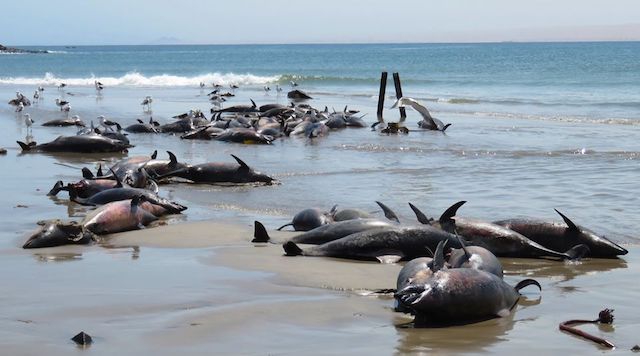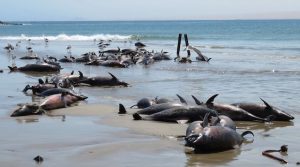ALTHOUGH the cause of the deadly beaching of 86 dusky dolphins near Lüderitz last week cannot be pinpointed, marine biologists may have narrowed it down to a “fast and drastic” event.
The mammals, which included two newborns and several juveniles, were discovered on the beach off Hottentots Bay, 60 kilometres north of Lüderitz, by a crew of a lobster vessel last Friday.
It is suspected they were beached about a week before they were discovered, and may have suffered a “slow death” being out of their natural water habitat, according to senior marine biologist of the Ministry of Fisheries and Marine Resources at Lüderitz Kolette Grobler.
On Monday, scientists’ guesses were that one of the pod’s members was injured or sick and ventured to the shallows where it sent a distress call, attracting the other dolphins to rally around it – to their own detriment.
Another theory is that the animals may have become disoriented and accidentally beached themselves. One suspect reason may be due to seismic surveys in Namibia’s southern sea to locate oil and gas.
A third theory is the dolphins may have preyed on smaller fish, such as pilchards that may have ingested toxic plankton in the area.
Grobler yesterday told The Namibian that the toxic plankton theory can be scrapped, considering data showed there were no toxic blooms in the ocean in the area during the past few weeks. She added that information also shows the beaching happened quickly – even overnight.
Had it been toxic plankton, the beaching would have played out over a longer period.
According to interviews with the crew of the lobster vessel, who discovered the beached pod, they did not notice toxic blooms, neither did they notice extended or large-scale dolphin activity in the area where they had anchored the vessels for a few days. However, when the vessel made the rounds, it noticed the beaching of the dolphins within a very concentrated area which suggests that something “dramatic” may have happened.
“This shows that maybe the animals did rally around one of their members due to distress, or they were hunted by orcas, and out of frantic attempts to escape, they ended up on the beach. Orcas have hunted dolphin here before,” explained Grobler.
She said it was important for scientists to know the cause of the beaching, and that more information as to the schedule of seismic surveys is also being awaited.
“I, however, don’t think we will get any further as to what may have caused this,” she said.
She said this may have been the biggest fatal stranding of dolphins since she started working nearly 30 years ago. There was another mass stranding of about 33 animals about five years ago, but all of them were assisted to return to the ocean, she said.
Simon Elwin who founded the Namibian Dolphin Project, although they did not attend to the incident, did add his expertise on their Facebook page, stating that the event was “indeed unusual” and that “the majority of those animals were probably healthy”.
“No foul play is suspected – there were no reports of entanglement (mass drownings of dolphins is something that happens a lot in the EU with trawl fisheries) and there were no seismic surveys anywhere nearby that we are aware of. Possible causes? One or more sick animals and the others stayed with it but then got trapped by a dropping tide? Perhaps the group responded to a killer whale attack offshore (dusky dolphins are known to come right into the shallows in response to this),” said Elwin.
Source: namibian








